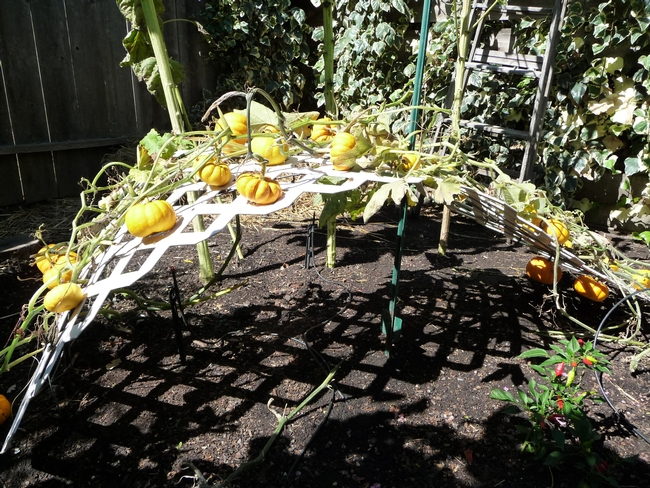
If you have lawn, feed with a nitrogen fertilizer from a garden supply store. Read label instructions thoroughly, apply correctly and irrigate immediately. For a lawn that is healthy but not overly vigorous, fertilize once in the fall and again in the spring. Do not apply more fertilizer than you need, and watch the runoff from your turf, too. Overwatering wastes fertilizer and pollutes our waters; use commercial fertilizers carefully and responsibly.
Toward the end of September, lower the blade on your lawnmower. Dethatch and aerate your lawn if it needs rejuvenating.
Feed perennials now, too. They have bloomed or produced all summer and need replenishing for a repeat performance next year. Apply bone meal or 0-10-10 fertilizer to encourage root growth and next year's flower buds. After feeding and watering, plump up the mulch so your soil is completely shaded. No light, no weeds. Be sure to keep mulch away from the plant's stem or base to prevent rot.
Irrigate your fruit trees and shrubs for the final time this year. They are still actively growing but will go dormant soon. Feed them with a 10-10-10 fertilizer in late September or early October. The fall rains will carry nutrients into the soil and prepare the trees for their winter beauty rest.
Camellias and azaleas don't need much nitrogen, but they do appreciate an application of 2-10-10 fertilizer now. The potassium and phosphorous will keep them healthy and help them produce strong buds for next year's display.
Dispose of any rotting vegetables or spent flowers. If they come from healthy plants, you can shred and compost this material. Otherwise, discard it in your green waste bin. Industrial composting temperatures are high enough to kill weed seeds and pathogens.
Re-dig your beds deeply and work in a few inches of well-composted organic matter. Many Master Gardeners use compost from Napa Recycling and Waste Services (http://naparecycling.com/compost/) or Upper Valley Disposal and Recycling (http://www.uvds.com/compostsales.htm.)Both companies produce excellent compost, although the products are a little different. Check the websites to learn about the specific materials and processes used.
If you “just can't wait” for the first strawberries of spring, it is time to plant them now. The same goes for artichokes, too. If you started seeds of cabbage, kale, cauliflower, broccoli, greens or celery last month, you can set the seedlings out in the garden now. And if you did not start seeds, you can purchase seedlings. There's still time to start seeds of cabbage and kale for setting out six weeks from now.
For years I admired gardens that were bursting with poppies, sweet peas, forget-me-nots and violets in early spring, while I was still looking at seed catalogs. It turns out that those gardeners were sowing their winter and spring flowers in September.
Some bulbs can go in the ground now, too. Look for sparaxis and fragrant freesias. Order from catalogs or bring home something new from the nursery. Some bulbs do well in garden beds, and on decks and patios in pots and containers. Others are happier in the ground. Do your homework for best results. Start prepping areas for planting native perennials, too.
If your chrysanthemums are beginning to get leggy or sprawl, gently tie them up. Pinch out all but one bud if you like large blossoms.
For color on your deck and close to the house as the weather cools, pot up pansies, violas, primroses, snapdragons, Icelandic poppies and cyclamen. Remember that if you put them under the roof eaves, they will need watering even after the rains begin.
Propagate frost-sensitive plants by taking softwood cuttings and keeping them in pots indoors for the winter. Dig up rooted side shoots of your favorite flowering shrubs and pot them up so you have duplicates. You have probably harvested most of your fruit trees, but if you are lucky enough to have late-season plums, apples, peaches or figs, it is probably time to harvest those, too.
Workshop: Join Napa County Master Gardeners for a workshop on “Critters in the Garden” on Sunday, September 21, from 2 p.m. to 4 p.m., at the Yountville Community Center, 6516 Washington Street, Yountville. Learn to identify and manage the many critters that invade your garden by air, by land and from underground. Learn techniques for managing gophers, moles, voles, rabbits, squirrels, deer and birds. To register, call the Yountville Parks & Recreation Department at 707-944-8712 or visit its web site.
Master Gardeners are volunteers who help the University of California reach the gardening public with home gardening information. Napa County Master Gardeners ( http://ucanr.org/ucmgnapa/) are available to answer gardening questions in person or by phone, Monday, Wednesday and Friday, 9 a.m. to Noon, at the U. C. Cooperative Extension office, 1710 Soscol Avenue, Suite 4, Napa, 707-253-4143, or from outside City of Napa toll-free at 877-279-3065. Or e-mail your garden questions by following the guidelines on our web site. Click on Napa, then on Have Garden Questions? Find us on Facebook under UC Master Gardeners of Napa County.